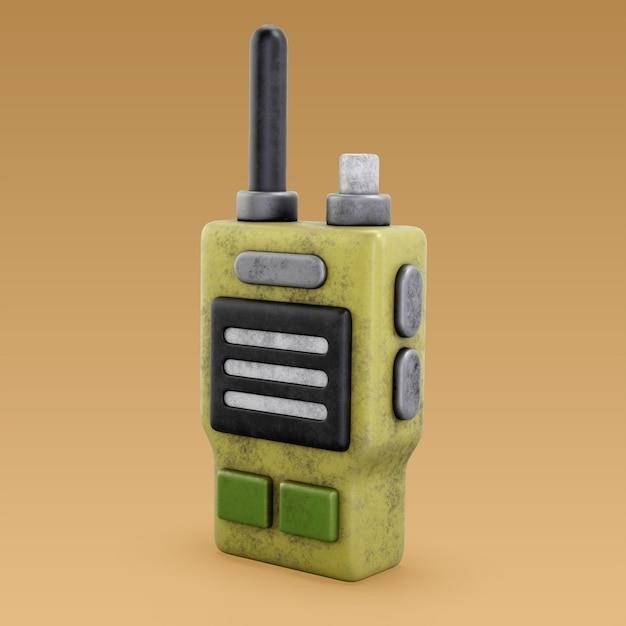Baofeng Radio Programming Guide
This guide provides a comprehensive overview of programming Baofeng radios‚ covering various aspects from basic setup to advanced features. It’s designed to be a practical resource for both beginners and experienced users seeking to maximize their Baofeng radio’s capabilities. Whether you’re a ham radio enthusiast‚ a professional communicator‚ or simply looking to enhance your communication options‚ this guide will equip you with the knowledge and tools needed to program your Baofeng radio effectively.
Introduction
Welcome to the world of Baofeng radios‚ where affordability meets versatility. These handheld transceivers have become incredibly popular among ham radio operators‚ emergency preparedness enthusiasts‚ and even individuals seeking reliable communication in remote areas. Baofeng radios are known for their compact size‚ robust construction‚ and surprisingly powerful capabilities‚ all at a price point that makes them accessible to a wide audience.
However‚ the ease of use that makes Baofeng radios so appealing can also lead to confusion when it comes to programming. Unlike some other radio models that feature intuitive menus and straightforward programming procedures‚ Baofeng radios often require a bit more technical knowledge and understanding. This guide aims to bridge that gap‚ offering a detailed exploration of Baofeng radio programming‚ providing clear instructions‚ and addressing common challenges.
Whether you’re a novice looking to set up your first Baofeng radio or an experienced user seeking to delve deeper into its capabilities‚ this guide will serve as your roadmap. We’ll cover everything from basic frequency assignments to advanced features like CTCSS/DCS tones‚ scanning‚ and even customizing your radio’s display; By the time you finish reading‚ you’ll have the confidence to program your Baofeng radio like a pro.
Programming Options
Programming your Baofeng radio involves configuring various settings and parameters to tailor its operation to your specific needs. The most common programming options include frequency assignment‚ channel creation‚ and setting up features like CTCSS/DCS tones and scanning. Fortunately‚ you have two main approaches to achieve this⁚
Using CHIRP Software⁚ CHIRP (Chirp for Radio) is a free and widely used software application designed specifically for programming various amateur radio transceivers‚ including Baofeng models. CHIRP offers a user-friendly interface‚ making it relatively straightforward to program frequencies‚ channels‚ and other settings. Its compatibility with multiple radio models‚ including Baofeng‚ makes it a popular choice for ham radio operators and hobbyists.
Manual Programming⁚ While CHIRP provides a convenient and efficient approach‚ you can also program your Baofeng radio manually using its keypad. This method involves navigating through the radio’s menus and entering settings directly. While it might seem daunting at first‚ manual programming offers a greater level of control and can be particularly useful in situations where you lack access to a computer or CHIRP software.
The choice between CHIRP and manual programming depends on your personal preference‚ technical expertise‚ and the specific programming tasks you intend to perform. Both methods have their advantages and disadvantages‚ and the best approach often boils down to your individual needs and comfort level.
Using CHIRP Software
CHIRP‚ a free and user-friendly software application‚ is a popular choice for programming various amateur radio transceivers‚ including Baofeng models. It provides a comprehensive interface for managing frequencies‚ channels‚ and other settings‚ making the process relatively simple. To use CHIRP‚ you’ll need a compatible programming cable to connect your Baofeng radio to your computer.
Once connected‚ CHIRP allows you to create and edit channels‚ assign frequencies‚ set up CTCSS/DCS tones‚ and configure other radio parameters. The software also supports various radio models‚ including Baofeng‚ making it versatile for different users.
Here’s a simplified outline of programming your Baofeng radio with CHIRP⁚
- Download and install CHIRP⁚ Obtain the latest version of CHIRP software from the official website and install it on your computer.
- Connect your radio⁚ Connect your Baofeng radio to your computer using a compatible programming cable. Ensure the cable is properly plugged into both the radio and your computer’s USB port.
- Select your radio model⁚ Open CHIRP and choose your Baofeng radio model from the list of supported devices. This will ensure that CHIRP recognizes your radio’s specific settings and parameters.
- Program your channels⁚ Create new channels‚ assign frequencies‚ and set up CTCSS/DCS tones as needed; CHIRP provides a user-friendly interface for managing these settings.
- Write the settings to your radio⁚ Once your programming is complete‚ use CHIRP to write the settings to your Baofeng radio. This will transfer the configuration from your computer to the radio’s memory.
- Verify your settings⁚ After programming your radio‚ it’s essential to verify that the settings are correctly applied. Turn on your Baofeng radio and test the channels and features you’ve configured.
CHIRP offers a convenient and efficient way to program your Baofeng radio‚ simplifying the process and providing a user-friendly interface for managing various settings.
Manual Programming

While CHIRP software offers a convenient way to program Baofeng radios‚ it’s possible to manually program your radio directly from its keypad. This method might be useful if you don’t have access to a computer or prefer a hands-on approach. However‚ manual programming can be more time-consuming and requires a good understanding of the radio’s functions and settings.
Here’s a simplified guide to manual programming⁚
- Enter Frequency Mode⁚ Press the VFO/MR button on your Baofeng radio to enter Frequency Mode. This mode allows you to directly input frequencies into the radio.
- Select the A Side⁚ Press the A/B button to choose the A side of the radio (the upper display). The A side is typically used for programming channels.
- Input the Frequency⁚ Use the numeric keypad to enter the desired frequency for the channel you want to program. Remember to double-check your input for accuracy.
- Set CTCSS/DCS Tones⁚ If you need to use CTCSS/DCS tones for your channel‚ navigate to the tone settings menu and select the desired tones. Refer to your Baofeng radio’s manual for specific instructions on setting tones.
- Store the Channel⁚ Once you’ve entered the frequency and tones‚ press the channel up or down button to select an empty channel slot. Then‚ press and hold the “A” button to store the channel into the selected slot.
- Repeat for Additional Channels⁚ Follow the same steps to program additional channels‚ assigning different frequencies and tones as needed.
- Verify Your Settings⁚ After programming your channels‚ test them by switching to the programmed channels and transmitting or receiving signals. Verify that the frequencies‚ tones‚ and other settings are correct.
Manual programming can be a bit more challenging‚ but it allows for direct control over your radio’s settings. Remember to refer to your Baofeng radio’s manual for detailed instructions and specific procedures for your model.
Frequency Modes
Baofeng radios typically operate in two primary frequency modes⁚ VHF (Very High Frequency) and UHF (Ultra High Frequency). Understanding these modes is crucial for selecting the appropriate frequencies and ensuring effective communication.
VHF frequencies generally range from 136 to 174 MHz and are often used for shorter-range communication; They are less susceptible to obstacles like buildings and hills‚ making them suitable for open areas or line-of-sight communication.
UHF frequencies‚ on the other hand‚ range from 400 to 480 MHz. They offer longer range and are better at penetrating obstacles‚ making them ideal for urban environments or areas with dense vegetation.
Baofeng radios often support both VHF and UHF frequencies‚ allowing for versatility in different communication scenarios. When programming your Baofeng radio‚ you’ll need to select the appropriate frequency band based on your intended use and the frequencies used in your area.
It’s important to note that the actual frequency ranges and specific channels available may vary depending on your location and local regulations. Consult your local amateur radio club or licensing authority for information on permitted frequencies in your area.
Channel Modes
Channel modes on Baofeng radios provide a structured way to organize and access different frequencies for communication. They offer a convenient way to store and recall specific frequency settings‚ simplifying the process of switching between different communication channels.
Typically‚ Baofeng radios offer two main channel modes⁚
- VFO (Variable Frequency Oscillator)⁚ This mode allows for manual frequency input‚ providing flexibility to communicate on any desired frequency within the radio’s supported range.
- MR (Memory Channel)⁚ This mode enables storing specific frequencies in memory channels‚ allowing for quick access to commonly used channels with a simple channel selection.
Each memory channel can store a unique frequency‚ transmit power level‚ and other settings‚ such as CTCSS (Continuous Tone-Coded Squelch System) or DCS (Digital Code Squelch) tones. CTCSS and DCS tones help filter out unwanted signals and ensure clear communication within a specific group.
When programming your Baofeng radio‚ you can define and store multiple memory channels for different communication purposes. This allows for easy switching between channels‚ such as your local repeater‚ emergency frequencies‚ or specific group channels.
Understanding the different channel modes and customizing them to your needs is essential for effectively utilizing your Baofeng radio for various communication purposes.
Understanding Baofeng Features
Baofeng radios are known for their versatility and array of features‚ catering to a range of communication needs. Familiarizing yourself with these features will enhance your understanding of the radio’s capabilities and allow you to utilize it effectively for various scenarios.
Key features commonly found on Baofeng radios include⁚
- Dual Band Operation⁚ Most Baofeng radios operate on both VHF (Very High Frequency) and UHF (Ultra High Frequency) bands‚ expanding your communication range and allowing for access to a wider range of frequencies.
- Dual Display⁚ Many Baofeng radios feature dual displays‚ providing simultaneous readings for both VHF and UHF frequencies. This allows for monitoring two channels simultaneously‚ increasing situational awareness and communication efficiency.
- Power Output Adjustment⁚ Baofeng radios often offer adjustable power output settings‚ typically ranging from low to high. Adjusting the power output allows for efficient communication while minimizing interference and battery consumption‚ especially in crowded frequency environments.
- CTCSS/DCS Tones⁚ These tones act as digital filters‚ allowing for selective communication within specific groups. They help block out unwanted signals and ensure clear communication within a designated channel.
- Scan Function⁚ This feature allows for automatic scanning of multiple channels‚ enabling you to monitor for activity across a range of frequencies. This can be particularly useful for identifying active channels or detecting emergency transmissions.
By understanding these features and how to utilize them effectively‚ you can optimize your Baofeng radio for various communication scenarios‚ maximizing its potential and ensuring clear and reliable communication.
Safety Precautions
While Baofeng radios are valuable communication tools‚ safety should always be a top priority. Using them responsibly and adhering to safety precautions is essential to prevent potential hazards and ensure a safe operating environment.
Here are some crucial safety precautions to keep in mind⁚
- Antenna Safety⁚ Avoid using a damaged antenna‚ as it can result in a minor burn if it comes into contact with the skin. Always ensure the antenna is securely connected to the radio and is not bent or broken.
- Radio Usage Near Aircraft⁚ Turn off your radio before boarding an aircraft‚ as radio transmissions can interfere with aircraft navigation systems. Adhere to airline regulations and crew instructions regarding radio usage during air travel.
- Radio Usage in Blasting Areas⁚ Turn off your radio before entering a blasting area‚ as radio signals can trigger detonations and pose a serious safety risk. Avoid using radios in environments where explosives are present.
- Headset/Earpiece Usage⁚ Limit the amount of time you use headsets or earpieces at high volumes to prevent potential hearing damage. Always use the lowest volume necessary for clear communication. If you are in noisy surroundings‚ turn up the volume only if needed and turn it down before adding a headset or earpiece.
- Body-Worn Radio Safety⁚ If you wear a radio on your body‚ ensure the radio and its antenna are at least 2.5 centimeters away from your body when transmitting. This helps minimize potential exposure to radio frequency electromagnetic energy;
By following these safety precautions‚ you can ensure the responsible and safe operation of your Baofeng radio‚ minimizing potential risks and promoting a secure communication environment.
Legal Considerations
Using a Baofeng radio comes with legal considerations that are crucial to understand and adhere to. Operating a radio transmitter without proper authorization or within restricted frequency bands can lead to legal penalties and fines.
Here are some key legal considerations to be aware of⁚
- Amateur Radio Licensing⁚ In many countries‚ operating a radio transmitter on certain frequencies requires an amateur radio license. These licenses ensure that operators have the necessary knowledge and skills to operate radio equipment responsibly and safely. The licensing process involves passing an exam that tests your understanding of radio theory‚ regulations‚ and operating procedures. Obtaining an amateur radio license is essential for legal and responsible radio operation.
- Frequency Bands⁚ Different frequency bands are allocated for specific purposes. It’s crucial to operate your Baofeng radio within the designated frequency bands allocated for amateur radio or other authorized uses. Transmitting on unauthorized frequencies can interfere with other services‚ disrupt communication‚ and result in legal consequences.
- Power Output Limits⁚ Radio transmitters have power output limits that are regulated by government agencies. Exceeding these limits can cause interference with other radio services and potentially harm equipment or individuals. Always operate your Baofeng radio within the specified power output limits to comply with regulations.
- Privacy and Security⁚ Be mindful of privacy and security considerations when using your Baofeng radio. Avoid transmitting sensitive information that could be intercepted by unauthorized individuals. Use encryption or other security measures to protect your communications if necessary.
Staying informed about local laws and regulations regarding radio operation is essential for responsible and legal use of your Baofeng radio.
Troubleshooting
While Baofeng radios are generally reliable‚ you may encounter issues from time to time. Identifying and resolving these issues can be frustrating‚ but a methodical approach can help you get back on the air quickly.
Here’s a breakdown of common troubleshooting steps⁚
- Check the Basics⁚ Begin by verifying that the radio is turned on‚ the volume is adjusted correctly‚ and the antenna is securely connected. A loose antenna or a low volume setting can significantly affect reception and transmission.
- Battery Issues⁚ A weak or faulty battery can cause problems with radio performance. Ensure your battery is fully charged. If the issue persists‚ try a fresh battery. If the battery is new‚ it might be defective.
- Channel Selection⁚ Double-check that you are transmitting and receiving on the correct channels. Ensure both the transmitting and receiving radios are programmed with the same frequencies and settings.
- Interference⁚ Radio interference can come from various sources‚ including other electronic devices‚ power lines‚ or even other radio users. Try moving to a different location or adjusting your antenna to minimize interference.
- Software Programming⁚ If you have programmed your Baofeng radio using software‚ verify that the programming is accurate and up-to-date. Incorrect programming can lead to communication problems.
- Resetting the Radio⁚ If you’ve tried the above steps and are still experiencing issues‚ you can try resetting your Baofeng radio to factory settings. This will erase all custom settings and potentially resolve software-related problems.
If you’ve exhausted these troubleshooting steps and the issue persists‚ consult the user manual for your specific Baofeng model or seek assistance from a qualified radio technician.
Common Issues and Solutions
Baofeng radios‚ despite their popularity and affordability‚ can occasionally present users with a range of issues. Understanding the common problems and their solutions can help you keep your radio functioning smoothly. Here are some frequent concerns and how to address them⁚
- Poor Reception⁚ If you’re experiencing weak signal reception‚ check for interference from other electronic devices or power lines. Move to a different location or adjust your antenna position to reduce interference. Ensure your antenna is securely connected and that there are no obstructions blocking the signal path.
- Battery Drain⁚ Rapid battery drain can be caused by several factors. Ensure your radio is not transmitting unnecessarily. Excessive use of the flashlight or other power-hungry features can also contribute to battery drain. Consider using a high-capacity battery or a battery saver mode to prolong battery life.
- Radio Not Turning On⁚ If your Baofeng radio won’t power on‚ first confirm that the battery is properly installed and has sufficient charge. If the battery is charged and the radio still won’t turn on‚ try resetting the radio by removing and re-inserting the battery. If the issue persists‚ it could be a faulty power button or a more serious internal problem.
- Programming Errors⁚ Incorrect programming can lead to communication problems. Ensure that your programming software is up-to-date and that you are using the correct settings for your specific model. Verify that the channels and frequencies are programmed accurately.
- Static Noise⁚ Static noise during transmission or reception can be caused by interference from other devices‚ power lines‚ or atmospheric conditions. Try changing your antenna position or location to minimize static.
If you’re experiencing issues not covered here‚ consult the user manual for your specific Baofeng model or seek assistance from a qualified radio technician.

